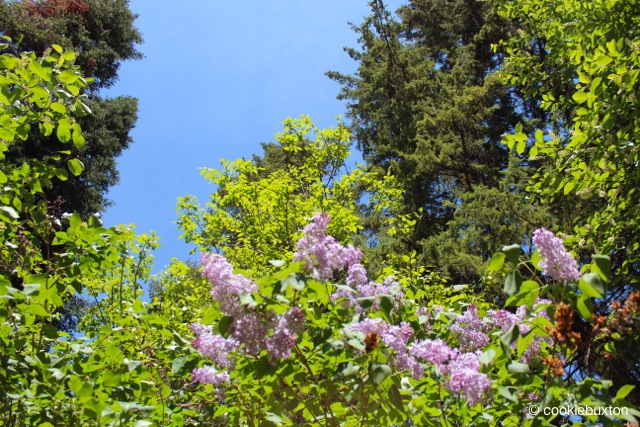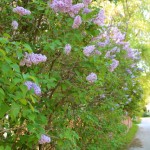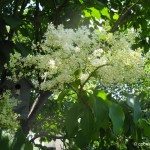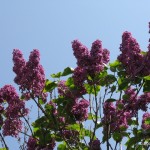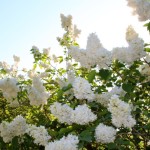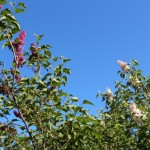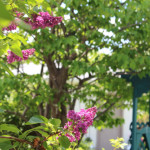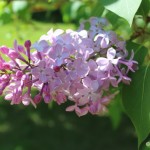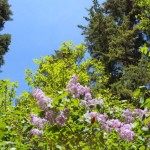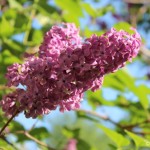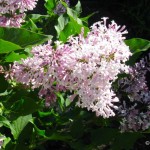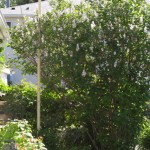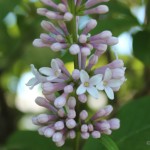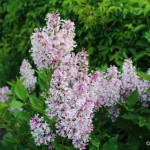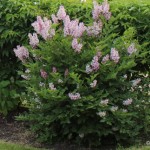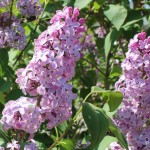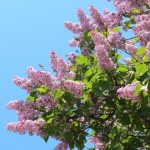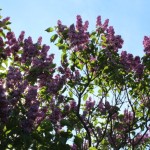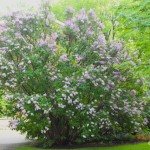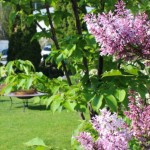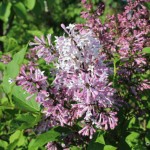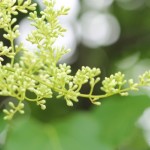Common Lilac
The scent of the common lilac is divine. The common lilac along with lily of the valley to my mind represent the best of what spring offers us in fragrance in my part of the world. Once these flowers fade, and the scented blossoms drop off of the flowering crab apples, the scent of roses and mock orange follow, signifying for me that the long days of summer are at their zenith. You can feel the change as day and night balance for a short while, before the light begins to drop off the horizon earlier and earlier each evening as the summer advances.
If I have not stopped during my weekend walks, pausing along a backlane or along the narrow sidewalk in my neighbourhood, and pulled in the lilac branches, breathing deeply into a cluster of common lilac – what I believe to be the species, Syrina vulgaris – then I have been going too fast, out of step with nature, missing the beauty of spring. It means I have let this short and glorious season slip by without cherishing the delightful smells of May and June.
Europeans, travelling across the ocean to the New World, brought bits of Asian lilac root with them and planted it on their homesteads. After the harsh winter, I can imagine how much they longed for something familiar to blossom and brighten the day.
The common lilac that has naturalized in Canada and throughout North America is said to have migrated through eager botanists into Europe during the height of Turkey’s Ottoman empire in the 1500s. Some plants may have come as well from the Balkan Penninsula area. Of the 20 or so species of lilac, I’ve read that two are from Europe. The great majority of the plants originate in Asia. Popular choices of Asian lilacs in today’s gardens include Syringa patula ‘Miss Kim’ and Syringa meyeri ‘Palibin.’
I planted a baby ‘Miss Kim’ three years ago in my garden, and it has settled in beautifully. It is now flowering above the height of my four-foot fence and above the extra six-inches of height from the Virginia Creeper that hugs the fence. The flowers this year were very pretty, and the fragrance lovely. As well, I have a pink lilac shrub that adds to the beauty of the yard in late May, enjoy my neighbour’s deep lavender lilac that leans over the fence (it has been in that location over 25 years and the name is lost), and love my two beautiful Japanese tree lilacs in my yard.
Lilacs are cold climate plants. I like to keep this in mind when I am in some region that has gorgeous flowers blooming on every shrub and tree and vine. Lilacs need a period of cold dormancy to produce flowers. I am grateful that this plant found its way to my part of the world, and that is has liked it here so much that we consider it to be a native plant.
My guests to Cookie Buxton who are plant breeders may know that Canadian Isabella Preston bred a series of pink and lavender S. vulgaris hybrids – Syringa x prestoniae – for hardiness in Canadian gardens. She introduced later-blooming varieties to protect the flowers from late spring frosts. It’s entirely possible that what I think of as the common lilac species in my neighbourhood is in fact one of these Syringa x prestoniae hybrids.
A lilac, however, by any name, would smell glorious. I am content not to know the name, whether species or hybrid, as long as I can sink my face in the blossoms and enjoy the memorable scent of lilacs for a few days each year.
It is a very long wait to enjoy two-weeks of bloom, but it is well worth it, year after year.
Photos and text: NKampen
Photo locations: Winnipeg and Selkirk neighbourhoods, my back yard.
Copyright: cookiebuxton, NKampen
PHOTO GALLERY
Click on any photograph to enlarge, and click on the photo to advance through the series.
- Common Lilac
- Japanese Tree Lilac
- White Lilac
- Miss Kim
- Pink Lilac
- Pink Lilac
- Miss Kim
- Miss Kim, baby
- Common Lilac
- Miss Kim Lilac
- Miss Kim Lilac
- Japanese Tree Lilac
